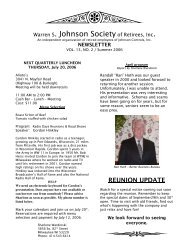TIME? - Johnson Controls Inc.
TIME? - Johnson Controls Inc.
TIME? - Johnson Controls Inc.
Create successful ePaper yourself
Turn your PDF publications into a flip-book with our unique Google optimized e-Paper software.
The Warren <strong>Johnson</strong>-designed floral clock at the<br />
1904 St. Louis World’s Fair.<br />
Construction begins on great floral clock for 1904<br />
World’s Fair, August 1, 1903<br />
The August 1, 1903, edition of the New York<br />
Evening Post reported that work had begun on<br />
the mammoth floral clock designed by <strong>Johnson</strong><br />
Service Company’s (<strong>Johnson</strong> <strong>Controls</strong>’ former<br />
name) founder and president Warren <strong>Johnson</strong> for<br />
the St. Louis World’s Fair the following year.<br />
The company had been engaged in the design<br />
From<br />
the archives…<br />
-6-<br />
and installation of clocks for building towers<br />
since 1895, including the two largest clocks in<br />
the world up to that time: the Minneapolis Court<br />
House and City Hall clock (built in 1895), with<br />
dials 23 feet, 4 inches in diameter, and the<br />
Philadelphia City Hall clock (built in 1898), with<br />
dials 25 feet in diameter (by contrast, London’s<br />
“Big Ben,” the previous record holder, had clock<br />
dials that were “only” 22 feet, 6 inches in<br />
diameter). Situated on a hillside to the north of<br />
the Fair’s Agricultural Palace, the floral clock’s<br />
dial had a diameter of 112 feet – dwarfing even<br />
the company’s own tower clocks. The clock’s<br />
hands, 50 feet and 74 feet in length respectively,<br />
could be read easily from a half-mile away. At<br />
night, the clock was illuminated with 1,000<br />
incandescent lights embedded in the flowers. As<br />
with all of the company’s tower clocks, the floral<br />
clock was driven pneumatically using the same<br />
principles used to power the company’s<br />
automatic temperature regulation systems. The<br />
mechanisms which ran the floral clock, including<br />
an astronomical master clock which controlled<br />
the main clock, were housed in three small<br />
pavilions at the top of the hill. 13,000 flowering<br />
plants filled up the clock’s face including twelve<br />
distinct species selected to bloom at twelve<br />
different times a day to help mark the hours. At<br />
the end of the Fair’s run, the Fair’s International<br />
Jury of Awards conferred a Grand Prize with<br />
Special Mention upon the <strong>Johnson</strong> Service<br />
Company for its creation of the floral clock.<br />
After Warren <strong>Johnson</strong>’s death in 1911, the<br />
company began to focus its efforts on its<br />
temperature control business exclusively,<br />
resulting in the sale of the clock business to Hahl<br />
Clock Co. of Chicago in 1912.











![[PDF] Intelligent Fire Annunciator IFA-1000 - Johnson Controls Inc.](https://img.yumpu.com/7424420/1/190x245/pdf-intelligent-fire-annunciator-ifa-1000-johnson-controls-inc.jpg?quality=85)




